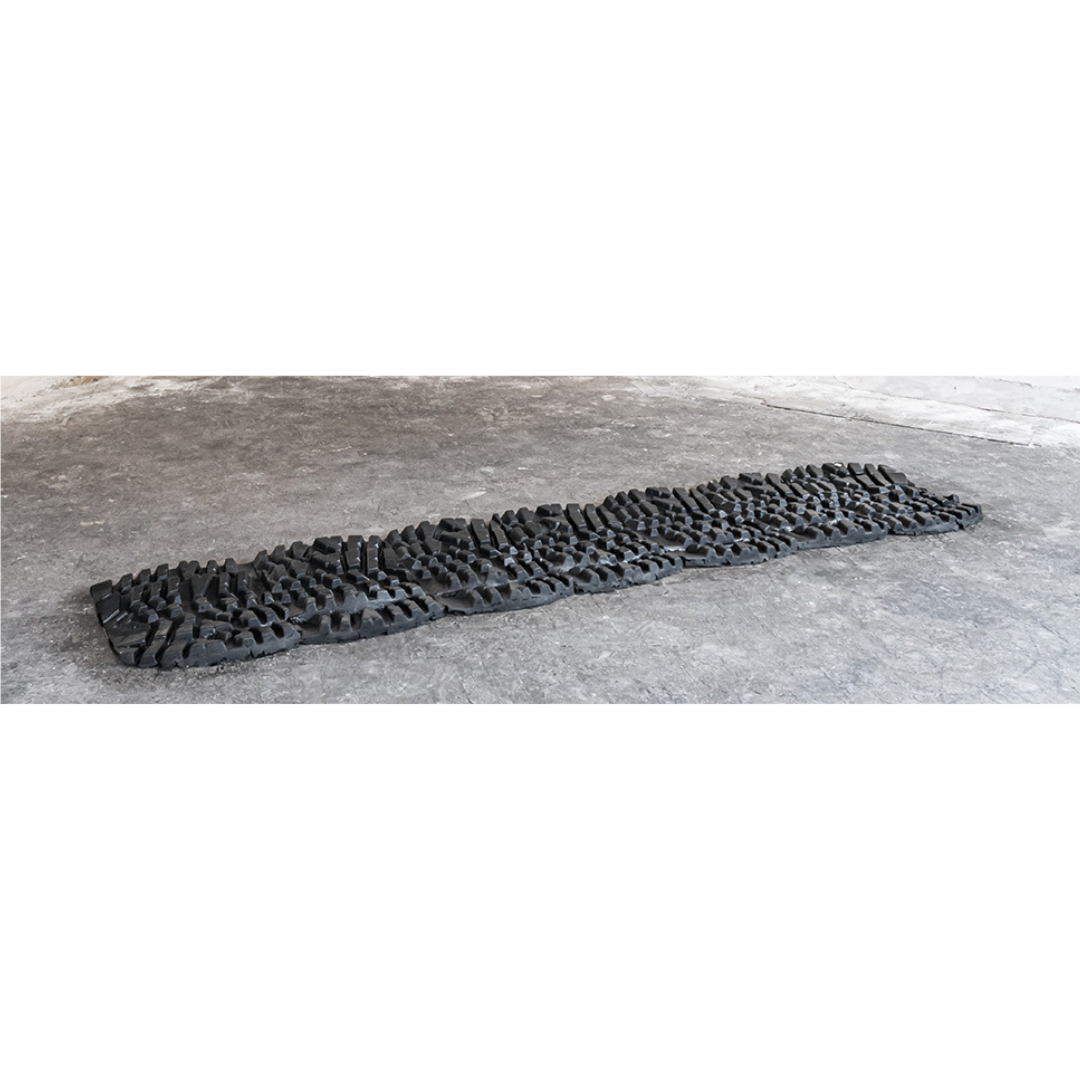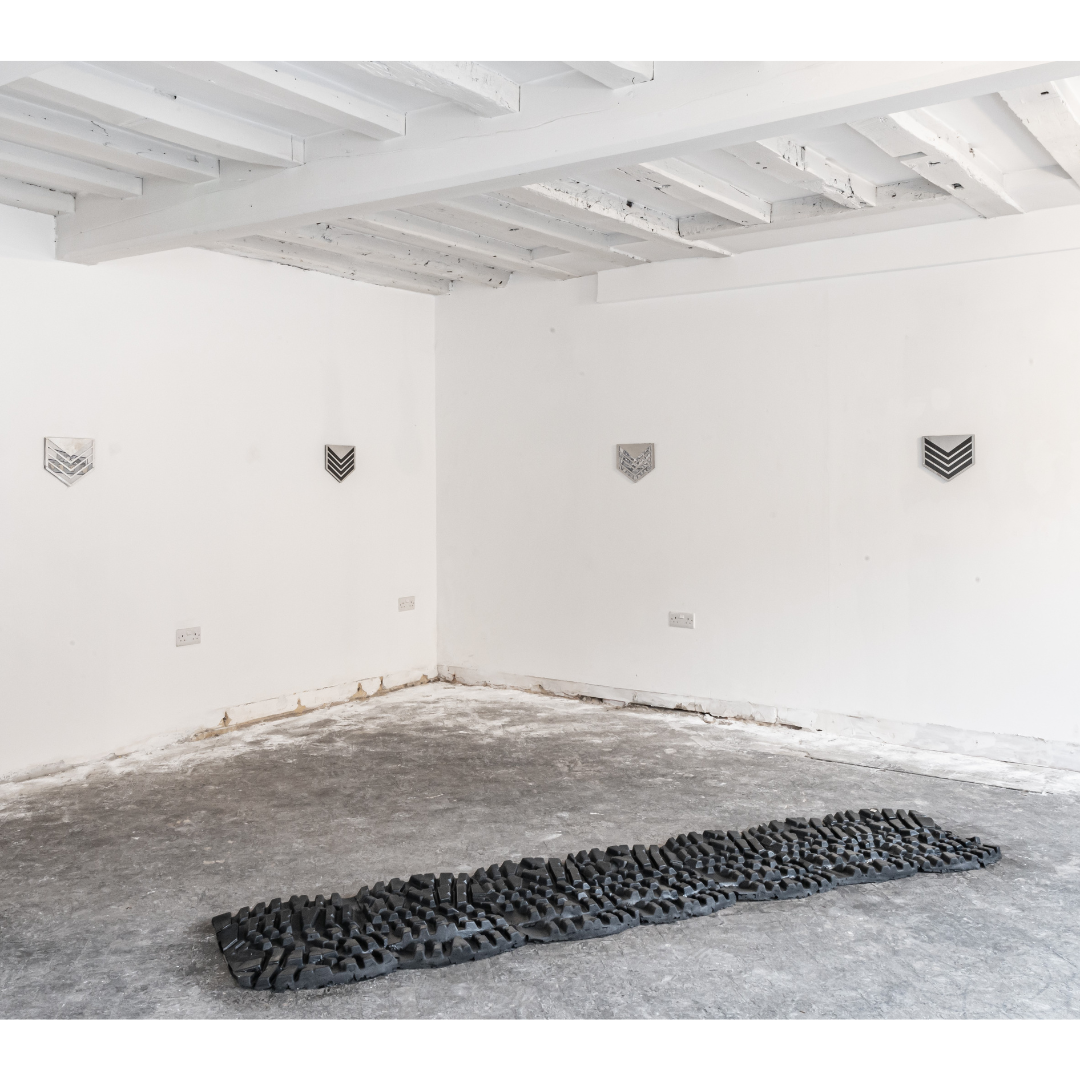





Close Considerations
Surreal banality: Its mythical dimensions propel Dragon Skin into an imaginative, surreal space, which engages audiences beyond its banal objecthood. Mirroring the imposing scale and ambition of oversized Fascist and Communist statues, the work points to the absurdity and terror of representations of masculinity meant to convey ideals of strength and virtue of the collectivist regimes.
Tactile duality: The polyurethane material is hard and toxic but also flexible, incorporating elements of both the industrial and the sensual to elicit a multi-sensory response. The combination alludes to the unspoken eroticism in the idea of the boot sole as well as other oversized parts of the statues.
Imposing quietude: Despite its large size, Dragon Skin employs a quiet minimalist form, which along with the scale, is imbued with regality and foreboding. This ambiguity in emotional response is intentional, hinting at the multifaceted nature of power and its associated systems.
Morbid monochrome and predatory pose: The colour and surface evoke associations with industrial waste, pollution, and even death, suggesting potential danger. Additionally, the work's long snake-like biometric form coupled with the diagonal placement on the floor amplifies its quiet menace, drawing comparisons to a stealthy crocodile.




Process
Quantitative Analysis of Uniform Design: Papandreopoulos's research begins with historical uniform reference books and catalogues, which provide a basis for a quantitative analysis of uniform design. This analysis involved measuring and comparing features like colour, fabric type, silhouette, and ornamentation across various cultures' military uniforms, results of which were then explored in the context of cultural attitudes towards masculinity.
Digital Prototyping: Following a rigorous selection process, a specific design element was chosen for initial development focusing on military footwear, from which several sketches were created. Papandreopoulos then employed computer-aided design (CAD) software to generate intricate sketches visualising the chosen element.
Iterative design process and material exploration: Initially the work was envisioned in a bent form. However, through his iterative design process, Papandreopoulos discovered the increased potency of a flat, snake-like form. He tested various materials (rubber and silicone) to achieve the desired visual resemblance to the source design. The chosen materials were selected to elicit a tactile response reminiscent of skin.
Fast-setting material property: Dragon Skin utilises a fast-setting polyurethane material, requiring rapid adjustments during the creation process. The fast-paced and stressful nature of working with this material reminded Papandreopoulos of the dangerous regimental exercises he experienced during his military service, which increased its appeal for this particular work.




References
Military Attire: Papandreopoulos's work utilises historical uniform reference books and catalogues as a source for the semiotic analysis of military attire across various cultures. This analysis delves into the symbolic meanings embedded in different uniform elements, enabling an exploration of how cultures use clothing to construct and communicate power.
Authoritarian aesthetic discourse: Papandreopoulos’s monumental, banal objects reference the historical practice of using scale to reinforce power. He has mentioned the colossal pharaoh statues of ancient Egypt, where size directly correlated with a ruler's authority, and more recently, collectivist regimes like Nazi Germany and the Soviet Union employed oversized sculptures of idealised bodies, to overwhelm viewers and instil awe, reinforcing the state's supposed invincibility, right to control as well as to direct citizens’ aspirations.
Tom of Finland’s erotic deviance: Papandreopoulos identifies an aesthetic parallel between the exaggerated masculinity depicted by the collectivist regimes of Nazi Germany and the Soviet Union and Tom of Finland's work which directly deals with their sexual appeal, which the former was fundamentally against. Tom of Finland's work utilises extreme versions of masculinity in uniforms, blurring the line between art and pornography. This reference presents masculinity as a potentially transgressive concept as an individualised erotic deviance in its own right.
Military conscription: A lot of Papandreopoulos’s art practice draws influence from his experience in the Greek military. This experience sharpened his observations of symbols used to establish and reinforce hierarchies and power structures. These symbols can be observed in the imposition of stoic aesthetics, adherence to austerity, enforced uniformity, and emphasis on order. Notably, these elements extend beyond the military context, influencing civilian life through state and corporate control mechanisms.
Samuel Beckett’s examination of disoriented masculinity: The exhibition title originated from Samuel Beckett's short story titled "Echo's Bones," which explores themes of violence and manhood. The regimented life depicted in Papandreopoulos's "Echo's Bones" exhibition, mirroring Beckett's characters in Theatre of the Absurd plays, reflects a potential loss of identity. This suggests a parallel between the disorientation experienced by soldiers in a highly structured environment and the struggles faced by contemporary men grappling with traditional notions of masculinity.
Francis Bacon’s examination of power: By analysing the connections between Samuel Beckett's penultimate work and Francis Bacon's late paintings, a link can be established with Papandreopoulos's practice. All three artists explore the nature of masculinity, portraying it as a constantly shifting concept characterised by doubt and complexity. Their work suggests that male identity is not fixed but rather allows for fluidity and the potential for transformation.


